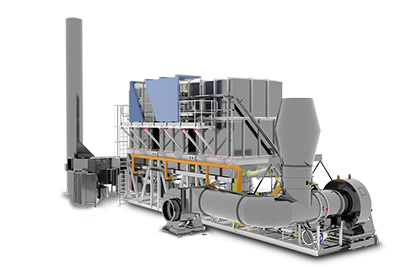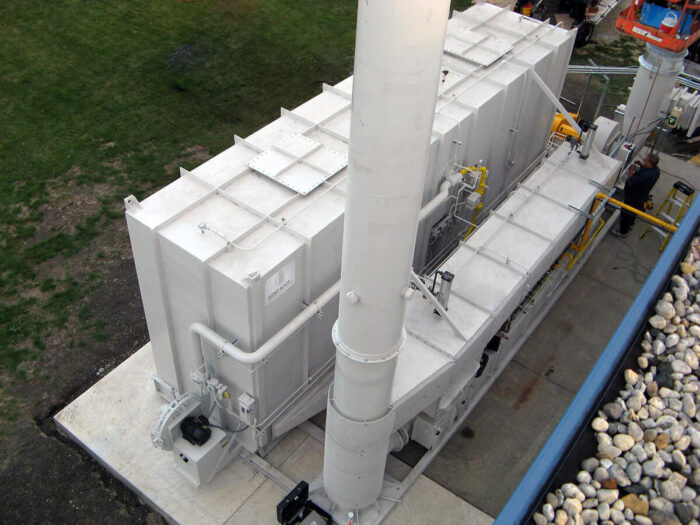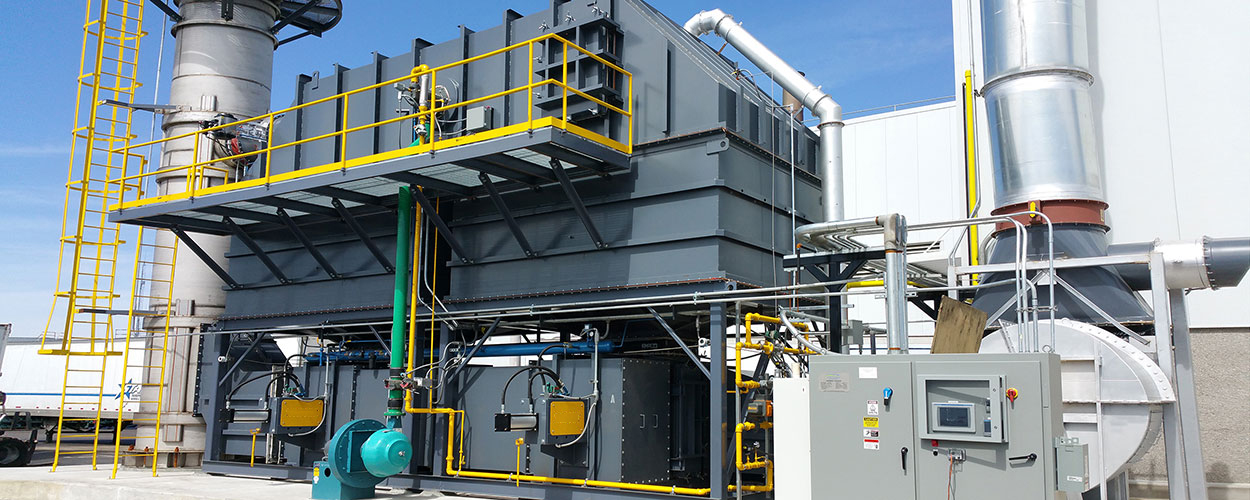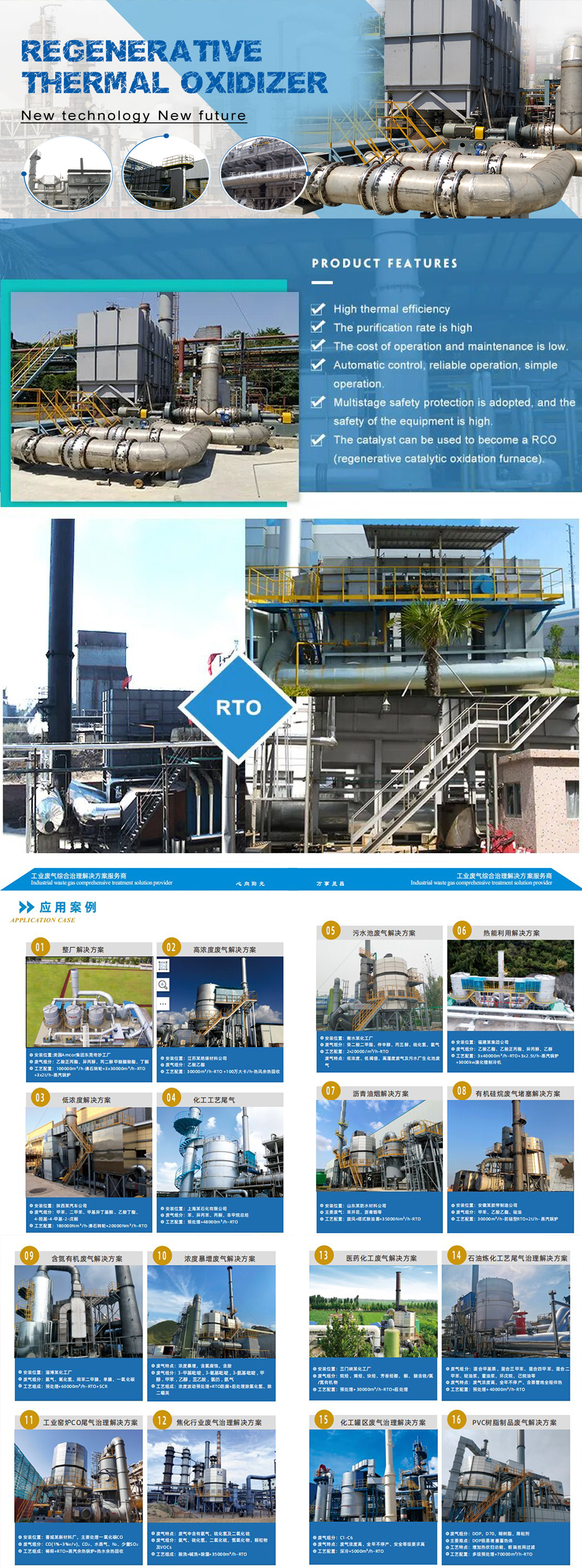معلومات اساسية.
نموذج رقم.
رتو
Processing Methods
Combustion
Pullution Sources
Air Pollution Control
العلامة التجارية
RUIMA
أصل
الصين
رمز النظام المنسق
84213990
وصف المنتج
Regenerative Thermal Oxidizer (RTO);
The most widely used oxidation technique nowadays for
VOC emission reduction,; suitable for treating a wide range of solvents and processes.; Depending on air volume and required purification efficiency,; a RTO comes with 2,; 3,; 5 or 10 chambers.;
المزايا
Wide range of VOC’s to be treated
Low maintenance cost
High Thermal Efficiency
Does not generate any waste
Adaptable for small,; medium and large air flows
Heat Recovery via bypass if VOCs concentration exceed the auto-thermal point
Auto-thermal and Heat Recovery:;
Thermal Efficiency > 95%
Auto-thermal point at 1.;2 – 1.;7 mgC/Nm3
Air flow range from 2,; 000 up to 200,; 000m3/h
High VOC’s destruction
The purification efficiency is normally in excess of 99%
Address: No 3 North Xihu (West Lake) Dis. Road, Xihu (West Lake) Dis., HangZhou, ZheJiang , China
نوع العمل: مصنع/شركة مصنعة
Business Range: Manufacturing & Processing Machinery, Service
Management System Certification: ISO 14001, ISO 9001, OHSAS/ OHSMS 18001, QHSE
Main Products: Dryer, Extruder, Heater, Twin Screw Extruder, Electrochemical Corrosion Protection Equ, Screw, Mixer, Pelletizing Machine, Compressor, Pelletizer
Company Introduction: The Res. Inst of Chem. Mach of the Ministry of Chemical Industry was founded in ZheJiang in 1958, and moved to HangZhou in 1965.
The Res. Inst of Automation of the Ministry of Chemical Industry was founded in HangZhou in 1963.
In 1997, the Res. Inst. Of Chem. Mach of the Ministry of Chemical Industry and the Res. Inst. Of Automation of the Ministry of Chemical Industry were combined to become the Res. Inst of Chemical Machinery and Automation of the Ministry of Chemical Industry.
In 2000, the Res. Inst of Chemical Machinery and Automation of the Ministry of ChemicalIndustry completed its transformation to enterprise and registered as CHINAMFG Instituteof Chemical Machinery and Automation.
Tianhua Institute has the following subordinated institutions:
Supervision and Inspection Center of the Quality of Chemical Equipments in HangZhou, ZheJiang Province
HangZhou Equipment Institute in HangZhou, ZheJiang Province;
Automation Institute in HangZhou, ZheJiang Province;
HangZhou Ruima Chemical Machinery Co Ltd in HangZhou, ZheJiang Province;
HangZhou Ruide Drying Technology Co Ltd in HangZhou, ZheJiang Province;
HangZhouLantai Plastics Machinery Co Ltd in HangZhou, ZheJiang Province;
ZheJiang Airuike Automation Technology Co Ltd in HangZhou, ZheJiang Province;
The HangZhou United Institute of Chemical Machinery and automation and the HangZhou United Institute of Petrochemical Industry Furnaces were founded by CHINAMFG Institute and the Sinopec.
Tianhua Institute has an occupation area of 80 000m2 and a total asset of 1 Yuan (RMB). The annual output value is 1 Yuan (RMB).
Tianhua Institute has about 916 employees, 75% of them are professional personnel. Among them are 23 professors, 249senior engineers, 226 engineers. 29 professors and senior engineers enjoy national special subsidy, On 5 people the title of Middle-aged and Young Specialist with Outstanding Contribution to the P. R. China are conferred

How do regenerative thermal oxidizers compare to catalytic oxidizers?
Regenerative thermal oxidizers (RTOs) and catalytic oxidizers are both effective technologies used for controlling air emissions from industrial processes. While they serve a similar purpose, there are significant differences in their operation, efficiency, and applicability.
Here is a comparison between RTOs and catalytic oxidizers:
| Regenerative Thermal Oxidizers (RTOs) | Catalytic Oxidizers |
|---|---|
| Operation: | Operation: |
| RTOs achieve emission control through high-temperature combustion without the use of a catalyst. They rely on the thermal oxidation process, where VOCs and other pollutants in the exhaust gas are oxidized at high temperatures (typically between 1,400°F and 1,600°F) in the presence of excess oxygen. | Catalytic oxidizers utilize a catalyst (usually a precious metal, such as platinum, palladium, or rhodium) to facilitate the oxidation of VOCs and other pollutants at lower temperatures compared to RTOs. The catalyst lowers the activation energy required for the oxidation reaction, enabling it to occur at lower temperatures (around 600°F to 900°F). |
| Efficiency: | Efficiency: |
| RTOs are known for their high thermal efficiency. They utilize a regenerative heat exchanger system that recovers and transfers heat from the treated exhaust gases to the incoming untreated gases, significantly reducing fuel consumption. This heat recovery mechanism makes RTOs energy-efficient. | Catalytic oxidizers are generally more energy-efficient than RTOs because they operate at lower temperatures. The catalyst facilitates the oxidation reaction, allowing it to occur at lower temperatures, which reduces the energy requirement for heating the exhaust gas. |
| Applicability: | Applicability: |
| RTOs are particularly suitable for applications where the pollutant concentrations are high, or where there is a wide variation in flow rates or pollutant concentrations. They are commonly used for the control of volatile organic compounds (VOCs) and hazardous air pollutants (HAPs) in various industries, including chemical manufacturing, printing, coating, and pharmaceuticals. | Catalytic oxidizers are often preferred in applications where the pollutant concentrations are relatively low and relatively constant. They are effective for VOC control in applications such as automotive painting, printing, and food processing, where the VOC concentrations can be lower and more consistent. |
| Limitations: | Limitations: |
| RTOs have higher capital costs compared to catalytic oxidizers due to their complex design and heat recovery system. They also have a higher operating temperature, which may limit their applicability in certain processes or require additional heat recovery systems. | Catalytic oxidizers can be sensitive to poisons or contaminants in the exhaust gas that can deactivate or degrade the catalyst over time. Certain compounds, such as sulfur, silicones, or halogenated compounds, can potentially poison the catalyst, reducing its effectiveness and requiring periodic catalyst replacement or regeneration. |
When selecting between an RTO and a catalytic oxidizer, it is essential to consider the specific requirements of the application, including pollutant concentrations, flow rates, temperature requirements, and cost considerations. Consulting with environmental engineering professionals or equipment manufacturers can help determine the most suitable technology for a particular emission control need.

Are regenerative thermal oxidizers suitable for controlling emissions from printing presses?
Yes, regenerative thermal oxidizers (RTOs) can be suitable for controlling emissions from printing presses. Printing presses can emit volatile organic compounds (VOCs) and other air pollutants during the printing process, which need to be properly controlled to comply with environmental regulations and ensure air quality. Here are some key points regarding the suitability of RTOs for controlling emissions from printing presses:
- التحكم في الانبعاثات: RTOs are designed to achieve high destruction efficiencies for VOCs and hazardous air pollutants (HAPs). These pollutants are oxidized within the RTO at high temperatures, typically above 95% efficiency, converting them into carbon dioxide (CO2) and water vapor. RTOs effectively control and reduce emissions from printing presses.
- Compatibility: RTOs can be integrated into the exhaust system of printing presses, capturing and treating the emissions before they are released into the atmosphere. The RTO is typically connected to the exhaust stack of the printing press, allowing the VOC-laden air to pass through the oxidizer for treatment.
- High Flow Rates: Printing presses can generate significant exhaust volumes due to the printing process. RTOs are designed to handle high flow rates and can accommodate the varying exhaust volumes of printing presses. This ensures effective treatment of emissions even during peak production periods.
- السعة الحرارية: RTOs have the thermal capacity to handle the temperature variations in printing press emissions. The printing process can result in varying exhaust temperatures, and RTOs are designed to operate effectively within a wide range of temperature conditions.
- كفاءة الطاقة: تتضمن وحدات الاسترداد الحراري أنظمة تبادل حراري تسمح باستعادة الطاقة الحرارية وإعادة استخدامها. تلتقط المبادلات الحرارية داخل وحدة الاسترداد الحراري الحرارة من غازات العادم الخارجة وتنقلها إلى تيار الهواء أو الغاز الداخل للعملية. تعمل عملية استعادة الحرارة هذه على تحسين كفاءة الطاقة الإجمالية للنظام وتقليل الحاجة إلى استهلاك وقود إضافي.
- الالتزام باللوائح: Printing press emissions are subject to regulatory requirements for air quality and emissions control. RTOs are capable of achieving the necessary destruction efficiencies and can help printing press operators comply with environmental regulations. The use of RTOs demonstrates a commitment to sustainable practices and responsible management of air emissions.
It is important to note that the specific design and configuration of the RTO, as well as the characteristics of the printing press emissions, should be considered when implementing an RTO for a printing press application. Consulting with experienced engineers or RTO manufacturers can provide valuable insights into the proper sizing, integration, and performance requirements for controlling emissions from printing presses.
In summary, RTOs are a suitable technology for controlling emissions from printing presses, providing high destruction efficiencies, compatibility with printing press exhaust systems, handling high flow rates and temperature variations, energy efficiency through heat recovery, and compliance with environmental regulations.

ما هو المؤكسد الحراري المتجدد؟
المؤكسد الحراري التجديدي (RTO) هو جهاز متقدم للتحكم في تلوث الهواء يستخدم في التطبيقات الصناعية لإزالة المركبات العضوية المتطايرة (VOCs) والملوثات الجوية الخطرة (HAPs) والمواد الملوثة الأخرى المحمولة جوًا من غازات العادم. يعمل باستخدام درجات حرارة عالية لتحلل الملوثات أو أكسدةها حرارياً، وتحويلها إلى منتجات ثانوية أقل ضررًا.
كيف يعمل المؤكسد الحراري المتجدد؟
تتكون منظمة التدريب والتأهيل من عدة مكونات رئيسية وتعمل من خلال عملية دورية:
1. مدخل المجمع: تدخل غازات العادم التي تحتوي على الملوثات إلى نظام RTO من خلال غرفة المدخل.
2. أسرّة المبادل الحراري: يحتوي نظام RTO على أسرّة مبادل حراري متعددة مملوءة بوسائط تخزين حرارية، عادةً مواد سيراميكية أو حشوات منظمة. يتم ترتيب أسرّة المبادل الحراري في أزواج.
3. صمامات التحكم في التدفق: صمامات التحكم في التدفق تعمل على توجيه تدفق الهواء والتحكم في اتجاه غازات العادم عبر RTO.
4. غرفة الاحتراق: يتم الآن تسخين غازات العادم الموجهة إلى حجرة الاحتراق إلى درجة حرارة عالية، تتراوح عادة بين 1400 درجة فهرنهايت (760 درجة مئوية) و1600 درجة فهرنهايت (870 درجة مئوية). ويضمن هذا النطاق من درجات الحرارة الأكسدة الحرارية الفعالة للملوثات.
5. تدمير المركبات العضوية المتطايرة: تتسبب درجة الحرارة المرتفعة في غرفة الاحتراق في تفاعل المركبات العضوية المتطايرة والمواد الملوثة الأخرى مع الأكسجين، مما يؤدي إلى تحللها حراريًا أو أكسدة. تعمل هذه العملية على تحلل الملوثات إلى بخار الماء وثاني أكسيد الكربون وغازات غير ضارة أخرى.
6. استعادة الحرارة: تمر الغازات الساخنة النقية الخارجة من غرفة الاحتراق عبر غرفة الخروج وتتدفق عبر أسرّة المبادل الحراري الموجودة في المرحلة المعاكسة من التشغيل. تمتص وسائط تخزين الحرارة الموجودة في الأسرّة الحرارة من الغازات الخارجة، مما يؤدي إلى تسخين غازات العادم الواردة مسبقًا.
7. تبديل الدورة: بعد فترة زمنية محددة، تقوم صمامات التحكم في التدفق بتبديل اتجاه تدفق الهواء، مما يسمح لأسرّة المبادل الحراري التي كانت تقوم بتسخين الغازات الواردة مسبقًا باستقبال الغازات الساخنة من غرفة الاحتراق. ثم تتكرر الدورة، مما يضمن التشغيل المستمر والفعال.
مميزات المؤكسدات الحرارية المتجددة:
توفر منظمات التدريب الصناعي العديد من المزايا في مجال التحكم في تلوث الهواء الصناعي:
1. كفاءة عالية: يمكن لـ RTOs تحقيق كفاءة تدمير عالية، عادةً أعلى من 95%، وإزالة مجموعة واسعة من الملوثات بشكل فعال.
2. استعادة الطاقة: تسمح آلية استعادة الحرارة في أجهزة الاحتراق والتسخين بتوفير كبير في الطاقة. حيث يعمل التسخين المسبق للغازات الواردة على تقليل استهلاك الوقود المطلوب للاحتراق، مما يجعل أجهزة الاحتراق والتسخين والتسخين موفرة للطاقة.
3. فعالية التكلفة: على الرغم من أن الاستثمار الرأسمالي الأولي لنظام RTO يمكن أن يكون كبيرًا، فإن وفورات التكلفة التشغيلية على المدى الطويل من خلال استعادة الطاقة وكفاءة التدمير العالية تجعله حلاً فعالاً من حيث التكلفة على مدى عمر النظام.
4. الامتثال البيئي: تم تصميم منظمات تسجيل الهواء (RTOs) لتلبية لوائح الانبعاثات الصارمة ومساعدة الصناعات على الامتثال لمعايير جودة الهواء والتصاريح.
5. التنوع: يمكن لمعدات معالجة الغازات العادمة التعامل مع مجموعة واسعة من أحجام عوادم العمليات وتركيزات الملوثات، مما يجعلها مناسبة لمختلف التطبيقات الصناعية.
بشكل عام، تعتبر المؤكسدات الحرارية المتجددة أجهزة فعالة وذات كفاءة عالية للتحكم في تلوث الهواء وتستخدم على نطاق واسع في الصناعات لتقليل الانبعاثات وضمان الامتثال البيئي.

editor by CX 2024-01-30
